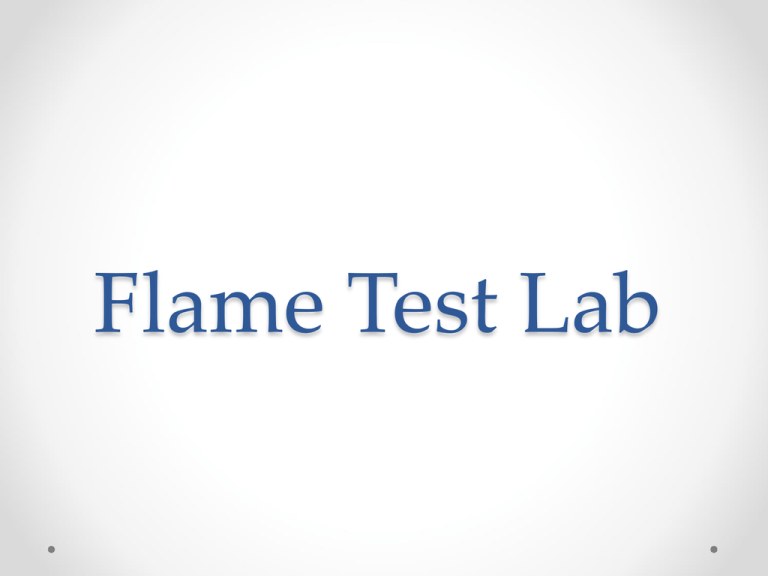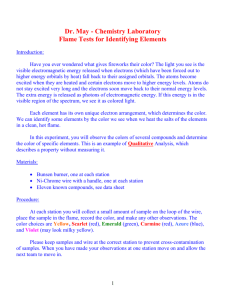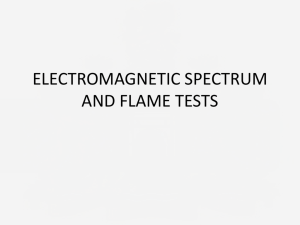Flame Test Lab - mcpchemistry1
advertisement

Flame Test Lab Think – Write – Pair - Share • List all the features we know about the structure of an atom. The Electronic Behavior of Atoms • Remember that protons are important in determining the identity of an atom. • However the electrons are equally important in determining the behavior of an atom. • The reactions that we see and experience on a daily basis are a result of the behavior of electrons! Remember Ionization Energy • Ionization energy is the amount of energy required to remove an electron. • Higher IE means that it is harder for an atom to lose an electron • Low IE means that it is easier for an atom to lose an electron. (In these cases, the element actually wants to lose an electron.) Think – Write – Pair – Share We know that when electrons are hit with a sufficient ionization energy, an electron will be removed. Question: So, what do you think will happen if we don’t add enough energy to completely remove an electron?? Think – Write – Pair – Share Question: So, what do you think will happen if we don’t add enough energy to completely remove an electron?? Answer: Electrons get excited! This doesn’t last though and they crash back down to their “ground state”. These electrons release a photon on the way down. Visible Spectrum • The photon released by the electron will have a different frequency, wavelength depending on the amount of energy released. • This specific amount of energy will also allow for a macroscopic observation: a specific color. Flame Test Lab What is the relationship between the following variables: wavelength, frequency, and energy? • Before we begin the lab, let’s write our ideas. (Use the questions below to help you brainstorm.) o What do you already know about light and different colors that we can see? o Where have you heard the terms wavelength and frequency? o What do already know about the definitions of wavelength and frequency? o How do you think wavelength and frequency are related to energy? o How do you think different elements compare in the energy they release? Safety Do Now Isabella was using a Bunsen burner during her flame test lab. While Julian was walking in the aisle, he tripped over a backpack and bumped into Isabella. During this accident her baggy sleeve passed too close to the flame and caught on fire. She screamed in panic and so did Julian, not sure what to do. The teacher hurried over and managed to smother the flame with a fire blanket, but Isabella had to go to the hospital to attend to her burn. 1. Identify two safety rules that could have prevented this situation. Bunsen Burner Procedure and Safety • To light a Bunsen Burner: 1. 2. 3. 4. 5. 6. 7. Make sure your lab space is clear of anything flammable. Methane gas is VERY flammable. Plug in the burner to the gas valve. Light a match FIRST Turn on the gas. Don’t turn on the gas prior to lighting the match. We don’t want methane gas flowing throughout the classroom. Bring the match slowly up from beneath the top of the burner. Avoid pointing the burner at anything (like a person) Light the burner and adjust the flame height using the gas valve. Helpful Hints • Rotate the splints in the flame. o The water evaporates causing the salt to reform producing more vibrant colors • Don’t drip! Flame Test Lab Materials Potassium chloride (KCl) Strontium chloride (SrCl2) Sodium chloride (NaCl) Calcium chloride (CaCl2) Copper (II) chloride (CuCl2) • Lithium chloride (LiCl) • • • • • Purpose • Today, we are taking our macroscopic observations. We will observe the characteristic colors of different elements. • Think about what is happening at the nanoscopic level. • Remember, our purpose is to determine the relationship between wavelength, frequency, and energy.





